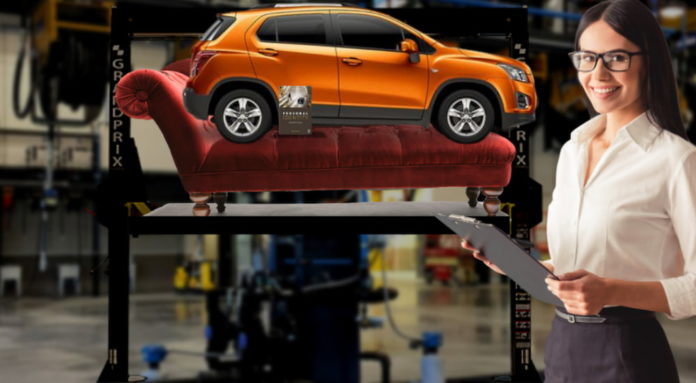Who am I? Why am I here? These are questions we all struggle with from time to time. This type of philosophical introspection has been particularly widespread during COVID, with disruptions to our regular schedule causing many of us to step back and reexamine our very sense of self. While this egotistical navel-gazing might seem like a problem unique to the human animal, it turns out that a global pandemic can drive even the most inanimate of objects straight into the psychiatrist’s chair. We took a look at the 2021 Chevy Trax vs 2021 Honda HR-V to prove our point.
“I just… just don’t know what I’m supposed to BE anymore,” says the 2021 Honda HR-V, splintering the chaise longue (it really is spelled this way and not ‘lounge’. Blame the French) of one Dr. Edmund MacLeod beneath its 102-inch wheelbase during a weekly session. “I mean, I have the cargo space and high off-the-ground seating of an SUV, but my fuel economy and price are more along the lines of a passenger car; it’s all just so confusing,” it says.
The subcompact concept has blurred the lines between the two vehicle classes. The “utility” aspect of the SUV has always been appealing to consumers, offering the cargo and towing benefits associated with trucks but wrapping it in a friendlier and more efficient package. The subcompact takes this one step further, integrating many of those same features but erring even more on the side of affordability and efficiency.
While this has given consumers the unprecedented ability to enjoy the best of both worlds, it has caused nothing less than a mental health crisis in the automotive community.
“Growing up, I always heard that some cars are blessed with better fuel efficiency, and some have more cargo capacity.” says the HR-V. “Now I find out I have 58 cubic feet of cargo space while still getting good gas mileage, and I can’t help but think––what else have they been lying to me about?”
Dr. MacLeod’s Drive-In Psychotherapy: Brakes and Pads has been busy this model year as almost 20 new subcompact SUVs rolled onto the market. With prices starting at just $22,000 and five star safety ratings all around, vehicles like the HR-V and Chevy Trax have created a boom for the man patients lovingly refer to as Sigmund Ford. “My patients deal with myriad issues, from Subcompact SUV Identity Disorder (SSUVID) to the guilt associated with killing off the sedan and small car class due to their versatility,” says MacLeod.
He reminds drivers that while regular oil changes and other routine maintenance are important, one shouldn’t neglect their vehicle’s emotional wellbeing either. “Buy them a new air freshener––lavender is particularly good for stress––or spring for the deluxe car wash. I know it might not seem like a lot, but sometimes a little hot wax undercoating can really make a car that’s questioning its very existence feel seen and cared for,” he says.
The Chevrolet Trax has been a leader in the segment since its debut on the U.S. market in 2015. With over 100,000 units sold in 2020, the Trax was the year’s best-selling subcompact SUV and no stranger to MacLeod’s couch. At 167 inches, the Trax is one of the smaller subcompact SUVs on the market, making it especially popular with crossover crazy city-dwellers.
“I can’t help but think that an SUV, a REAL SUV, is meant to be out there climbing mountains and traversing rocky gorges. At least that’s what all the commercials would have you think. I have optional AWD, so why can’t I be the one sending up a splash of mud at every turn?” asks the Trax. “But no. A big day for me involves picking up the kids from tennis, groceries, and maybe, if I’m lucky, a trip to the hardware store, where at least I feel like an actual utility vehicle by, like, hauling lumber or something,” it says.
MacLeod says that the impossible standards set by car commercials are taking a real toll on the mental health of today’s subcompact SUVs. The ad’s dramatic lighting, resonant voiceovers, and action-packed exploits have many in the class feeling less than, with some going to great lengths to feel like they fit in. “I’ve seen subcompacts rubbing dirt on their own fenders just to appear more ‘outdoorsy,’ and one more than one occasion, heard them narrating their own drive to the Little League field in Will Arnett’s melodramatic baritone,” he says.
The subcompact SUV’s emotional fragility might make them a little high-maintenance, but that’s the sort of maintenance most drivers would prefer. The HR-V’s 4-cylinder, i-VTEC 1.8 liter engine and Trax’s 4-cylinder ECOTEC 1.4 liter Turbo are both covered by a three-year, 36,000-mile warranty. While MacLeod’s psychiatric services aren’t included as part of the warranty, he has a few simple tips for drivers looking to keep their subcompact SUVs in the right lane and state of mind.
“Whether it’s the 2021 Chevy Trax or 2021 Honda HR-V, just remember to tell them that they’re the logical evolution of the current crossover trend, not some novelty hybrid that will go the way of the El Camino,” he says. “Make full use of their impressive storage capacity, let them feel a little dirt in their treads every now and then, and no matter what you do, don’t ever let them see a commercial where an SUV fords a river,” says MacLeod.













